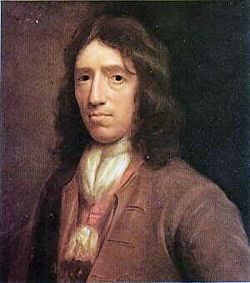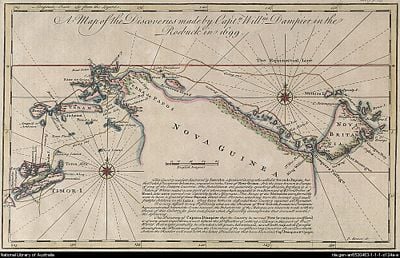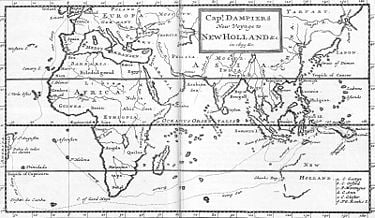Difference between revisions of "William Dampier" - New World Encyclopedia
({{Contracted}}) |
|||
| Line 2: | Line 2: | ||
[[Image:William Dampier - Project Gutenberg eText 15675.jpg|thumbnail|right|250px|William Dampier, pirate, navigator and explorer]] | [[Image:William Dampier - Project Gutenberg eText 15675.jpg|thumbnail|right|250px|William Dampier, pirate, navigator and explorer]] | ||
| − | '''William Dampier''' (baptised | + | '''William Dampier''' (baptised 5 September 1651 – died March 1715) was an [[England|English]] [[buccaneer]], sea captain, [[author]] and scientific observer. He was the first Englishman to explore or map parts of [[New Holland (Australia)|New Holland]] ([[Australia]]) and [[New Guinea]]. He was the first person to [[circumnavigate]] the world twice, and went on to complete a third circumnavigation. |
==First circumnavigation== | ==First circumnavigation== | ||
| − | [[Image:Dampier Mosquito.gif|thumbnail|left|250px|Map from "A New Voyage Round the World" | + | [[Image:Dampier Mosquito.gif|thumbnail|left|250px|Map from "A New Voyage Round the World," published in 1697 by William Dampier, the English sea captain, naturalist, and occasional pirate. |
The [[Miskito coast]] is marked with a star. Dampier and his associate, the surgeon and buccaneer [[Lionel Wafer]] describe the [[Miskito]] peoples in the period 1690-1700. These tribal groups, often mixed with runaway slaves, formed a distinct culture in the coastal region, sometimes forming alliances with pirates against Spanish authorities in the 16th-18th centuries.]] | The [[Miskito coast]] is marked with a star. Dampier and his associate, the surgeon and buccaneer [[Lionel Wafer]] describe the [[Miskito]] peoples in the period 1690-1700. These tribal groups, often mixed with runaway slaves, formed a distinct culture in the coastal region, sometimes forming alliances with pirates against Spanish authorities in the 16th-18th centuries.]] | ||
| − | In 1670s he crewed with [[buccaneer]]s on the [[Spanish Main]] of [[Central America]], twice visiting the [[Bay of Campeche]]. This led to his first circumnavigation: in | + | In 1670s he crewed with [[buccaneer]]s on the [[Spanish Main]] of [[Central America]], twice visiting the [[Bay of Campeche]]. This led to his first circumnavigation: in 1679 he accompanied a raid across the [[Darién Province|Isthmus of Darién]] in [[Panama]] and captured Spanish ships on the [[Pacific]] coast of that isthmus; the pirates then raided Spanish settlements in [[Peru]] before returning to the Caribbean. |
| − | Dampier made his way to [[Virginia]], where in | + | Dampier made his way to [[Virginia]], where in 1683 he engaged with the privateer [[John Cooke (Pirate)| John Cook (or Cooke)]]. Cook entered the Pacific via [[Cape Horn]] and spent a year raiding Spanish possessions in Peru, the [[Galapagos Islands]], and [[Mexico]]. This expedition collected buccaneers and ships as it went along, at one time having a fleet of ten vessels. In Mexico Cook died, and a new leader, Captain [[Edward Davis]], was elected captain by the crew. Dampier transferred to Captain [[Charles Swan]]'s ship, the ''Cygnet'', and on 31 March 1686 they set out across the Pacific to raid the [[East Indies]], calling at [[Guam]] and [[Mindanao]]. Leaving Swan and 36 others behind, the rest of the pirates sailed to [[Manila]], [[Pulo Condore]], [[China]], the [[Spice Islands]], and [[New Holland (Australia)|New Holland]] ([[Australia]]). |
| − | Early in | + | Early in 1688 ''Cygnet'' was beached on the northwest coast of Australia, near [[King Sound]]. While the ship was being [[careening|careened]] Dampier made notes on the fauna and flora he found there. Later that year, by agreement, he and two shipmates were marooned on one of the [[Nicobar Islands]]. They built a small craft and sailed it to [[Acheen]] in [[Sumatra]]. After further adventures Dampier returned to England in 1691 via the [[Cape of Good Hope]], penniless but in possession of his journals. |
Also was a pioneer | Also was a pioneer | ||
==The ''Roebuck'' expedition== | ==The ''Roebuck'' expedition== | ||
| − | [[Image:Map-dampier-roebuck-1699.jpg|thumbnail|right|400px|Map of the area charted in HMS ''Roebuck'' in | + | [[Image:Map-dampier-roebuck-1699.jpg|thumbnail|right|400px|Map of the area charted in HMS ''Roebuck'' in 1699]] |
| − | The publication of these journals as ''New Voyage Round the World'' in | + | The publication of these journals as ''New Voyage Round the World'' in 1697 created interest at the British [[Admiralty]] and in 1699 Dampier was given the command of [[HMS Roebuck (1690)|HMS ''Roebuck'']] with a commission to explore Australia and [[New Guinea]]. |
| − | The expedition set out on | + | The expedition set out on 14 January 1699, and on 26 July 1699 he reached [[Dirk Hartog Island]] at the mouth of [[Shark Bay]] in [[Western Australia]]. In search of water he followed the coast northeast, reaching the [[Dampier Archipelago]] and then [[Roebuck Bay]], but finding none he was forced to bear away north for [[Timor]]. Then he sailed east and on [[3 december]] 1699 sighted New Guinea, which he passed to the north. Sailing east, he traced the southeastern coasts of [[New Hanover Island|New Hanover]], [[New Ireland (island)|New Ireland]] and [[New Britain]], discovering the [[Dampier Strait]] between these islands (now the [[Bismarck Islands]]) and New Guinea. |
| − | On the return voyage to England, ''Roebuck'' foundered near [[Ascension Island]] on | + | On the return voyage to England, ''Roebuck'' foundered near [[Ascension Island]] on 21 February 1701 and the crew were marooned there for five weeks before being picked up on 3 April by an [[East Indiaman]] and returned home in August 1701. |
Although many papers were lost with the ''Roebuck'', Dampier was able to save many new charts of coastlines, trade winds and currents in the seas around Australia and New Guinea. | Although many papers were lost with the ''Roebuck'', Dampier was able to save many new charts of coastlines, trade winds and currents in the seas around Australia and New Guinea. | ||
| Line 32: | Line 32: | ||
He wrote an account of the 1699–1701 expedition, ''A Voyage to New Holland'' and returned to [[privateer]]ing. | He wrote an account of the 1699–1701 expedition, ''A Voyage to New Holland'' and returned to [[privateer]]ing. | ||
| − | The [[War of the Spanish Succession]] broke out in | + | The [[War of the Spanish Succession]] broke out in 1701 and English privateers were being readied to assist against French and Spanish interests. Dampier was appointed commander of the 26-gun government ship ''St George'', with a crew of 120 men. They were joined by the 16-gun galleon ''[[Cinque Ports (1703 ship)|Cinque Ports]]'' (63 men) and sailed on April 30 1703. |
En-route they unsuccessfully engaged a French ship but captured three small Spaniard ships and one vessel of 550 tons. | En-route they unsuccessfully engaged a French ship but captured three small Spaniard ships and one vessel of 550 tons. | ||
| − | [[Image:Capt Dampier's new voyage to New Holland &c in 1699 - Project Gutenberg eText 15675.jpg|thumbnail|left|375px|Capt Dampier's new voyage to [[New Holland (Australia)|New Holland]] &c in | + | [[Image:Capt Dampier's new voyage to New Holland &c in 1699 - Project Gutenberg eText 15675.jpg|thumbnail|left|375px|Capt Dampier's new voyage to [[New Holland (Australia)|New Holland]] &c in 1699]] |
| − | However, the expedition was most notable for the events surrounding [[Alexander Selkirk]]. The captain of the ''Cinque Ports'', Thomas Stradling fell out with Sailing Master Selkirk. In October | + | However, the expedition was most notable for the events surrounding [[Alexander Selkirk]]. The captain of the ''Cinque Ports'', Thomas Stradling fell out with Sailing Master Selkirk. In October 1704 the ''Cinque Ports'' had stopped at the uninhabited [[Juan Fernández Islands]] off the coast of [[Chile]] to resupply. Selkirk had grave concerns about the seaworthiness of ''Cinque Ports'' and after a disagreement with Dampier, he opted to remain on the island. Selkirk was to remain marooned for four years and 4 months and his experiences were to become the inspiration for [[Daniel Defoe]]'s [[Robinson Crusoe]]. |
Selkirk's misgivings were fully justified: ''Cinque Ports'' did later sink with the loss of most of her crew. | Selkirk's misgivings were fully justified: ''Cinque Ports'' did later sink with the loss of most of her crew. | ||
| − | Dampier returned to England in | + | Dampier returned to England in 1707 and in 1709 his ''A Continuation of a Voyage to New Holland'' was published. |
==Third circumnavigation== | ==Third circumnavigation== | ||
| − | Dampier was engaged in | + | Dampier was engaged in 1708 by the privateer [[Woodes Rogers]] as sailing master on the ''Duke''. This voyage was more successful: Selkirk was rescued on 2 February 1709, and the expedition amassed nearly £200,000 of profit. However, Dampier died in [[London]] in 1715 before he received his share. |
==Influence== | ==Influence== | ||
| Line 58: | Line 58: | ||
==Works== | ==Works== | ||
| − | *''A New Voyage Round the World'', ( | + | *''A New Voyage Round the World'', (1697) |
| − | *''Voyages and Descriptions'', ( | + | *''Voyages and Descriptions'', (1699) |
*#''A Supplement of the Voyage Round the World'' | *#''A Supplement of the Voyage Round the World'' | ||
*#''The Campeachy Voyages'' | *#''The Campeachy Voyages'' | ||
*#''A Discourse of Winds'' | *#''A Discourse of Winds'' | ||
| − | *''A Voyage to New Holland'', (Part 1 | + | *''A Voyage to New Holland'', (Part 1 1703, Part 2 1709) |
== Further reading == | == Further reading == | ||
| − | * | + | * Capoferro, Riccardo ''Frontiere del racconto. Letteratura di viaggio e romanzo in Inghilterra, 1690-1750'', Rome: Meltemi, 2007 ISBN 9788883535307 |
| − | * | + | * Gill, Anton ''Devil's Mariner: A Life of William Dampier, pirate and explorer'' London: Michael Joseph, 1997 ISBN 9780718141141 |
| − | * | + | * Preston, Diana and Michael ''A Pirate of Exquisite Mind: explorer, naturalist and buccaneer - the life of William Dampier'' NY: Walker & Co, 2004 ISBN 9780802714251 |
| − | * | + | * Rohers, Woods and Adams, Percy G ''Cruising Voyage Round the World'', NY: Dover, 1970 ISBN 9780486223049 |
| − | * | + | * Wilkinson, Clennell ''William Dampier'', London: John Lane at the Bodley Head, 1929 |
==External links== | ==External links== | ||
| − | * {{gutenberg author| id=William_Dampier | name=William Dampier}} | + | * {{gutenberg author| id=William_Dampier | name=William Dampier}} Retrieved September 8, 2007. |
| − | ** {{gutenberg|no=15675|name=A Voyage to New Holland}} | + | ** {{gutenberg|no=15675|name=A Voyage to New Holland}} Retrieved September 8, 2007. |
| − | ** {{gutenberg|no=15685|name=A Continuation of a Voyage to New Holland}} | + | ** {{gutenberg|no=15685|name=A Continuation of a Voyage to New Holland}} Retrieved September 8, 2007. |
| − | * Works by William Dampier: facsimile scans | + | * Works by William Dampier: facsimile scans (originals held by the National Library of Canada). |
| − | ** ''[http://www.canadiana.org/ECO/mtq?doc=34672 A new voyage round the world]'' | + | ** ''[http://www.canadiana.org/ECO/mtq?doc=34672 A new voyage round the world]'' Retrieved September 8, 2007. |
| − | ** ''[http://www.canadiana.org/ECO/mtq?doc=34673 Voyages and descriptions]'' | + | ** ''[http://www.canadiana.org/ECO/mtq?doc=34673 Voyages and descriptions]'' Retrieved September 8, 2007. |
| − | ** ''[http://www.canadiana.org/ECO/mtq?doc=34674 A voyage to New Holland]'' | + | ** ''[http://www.canadiana.org/ECO/mtq?doc=34674 A voyage to New Holland]'' Retrieved September 8, 2007. |
| − | ** ''[http://www.canadiana.org/ECO/mtq?doc=34675 A continuation of a voyage to New-Holland]'' | + | ** ''[http://www.canadiana.org/ECO/mtq?doc=34675 A continuation of a voyage to New-Holland]'' Retrieved September 8, 2007. |
| + | |||
| + | * [http://www.galapagos.to/BOOKS.HTM#DampierR Dampier Bibliography] from the [http://www.galapagos.to/ Human and Cartographic History of the Galápagos Islands] Retrieved September 8, 2007. | ||
| + | ** ''[http://www.galapagos.to/TEXTS/DAMPIER-0.HTM A New Voyage Round the World]'' (HTML version) Retrieved September 8, 2007. | ||
| + | |||
| + | * [http://www.adb.online.anu.edu.au/biogs/A010265b.htm J. Bach, 'Dampier, William (1651 - 1715)', ''Australian Dictionary of Biography'', Volume 1, Melbourne University Press, 1966, pp 277-278.] Retrieved September 8, 2007. | ||
| − | |||
| − | |||
| − | |||
| − | |||
| − | |||
| − | |||
| − | |||
| − | |||
| − | |||
| − | |||
| − | |||
| − | |||
| − | |||
| − | |||
| − | |||
| − | |||
[[Category:History and biography]] | [[Category:History and biography]] | ||
| − | |||
| − | |||
| − | |||
| − | |||
| − | |||
| − | |||
| − | |||
| − | |||
| − | |||
| − | |||
| − | |||
| − | |||
| − | |||
{{Credit|154562844}} | {{Credit|154562844}} | ||
Revision as of 18:48, 8 September 2007
William Dampier (baptised 5 September 1651 – died March 1715) was an English buccaneer, sea captain, author and scientific observer. He was the first Englishman to explore or map parts of New Holland (Australia) and New Guinea. He was the first person to circumnavigate the world twice, and went on to complete a third circumnavigation.

In 1670s he crewed with buccaneers on the Spanish Main of Central America, twice visiting the Bay of Campeche. This led to his first circumnavigation: in 1679 he accompanied a raid across the Isthmus of Darién in Panama and captured Spanish ships on the Pacific coast of that isthmus; the pirates then raided Spanish settlements in Peru before returning to the Caribbean.
Dampier made his way to Virginia, where in 1683 he engaged with the privateer John Cook (or Cooke). Cook entered the Pacific via Cape Horn and spent a year raiding Spanish possessions in Peru, the Galapagos Islands, and Mexico. This expedition collected buccaneers and ships as it went along, at one time having a fleet of ten vessels. In Mexico Cook died, and a new leader, Captain Edward Davis, was elected captain by the crew. Dampier transferred to Captain Charles Swan's ship, the Cygnet, and on 31 March 1686 they set out across the Pacific to raid the East Indies, calling at Guam and Mindanao. Leaving Swan and 36 others behind, the rest of the pirates sailed to Manila, Pulo Condore, China, the Spice Islands, and New Holland (Australia).
Early in 1688 Cygnet was beached on the northwest coast of Australia, near King Sound. While the ship was being careened Dampier made notes on the fauna and flora he found there. Later that year, by agreement, he and two shipmates were marooned on one of the Nicobar Islands. They built a small craft and sailed it to Acheen in Sumatra. After further adventures Dampier returned to England in 1691 via the Cape of Good Hope, penniless but in possession of his journals. Also was a pioneer
The Roebuck expedition
The publication of these journals as New Voyage Round the World in 1697 created interest at the British Admiralty and in 1699 Dampier was given the command of HMS Roebuck with a commission to explore Australia and New Guinea.
The expedition set out on 14 January 1699, and on 26 July 1699 he reached Dirk Hartog Island at the mouth of Shark Bay in Western Australia. In search of water he followed the coast northeast, reaching the Dampier Archipelago and then Roebuck Bay, but finding none he was forced to bear away north for Timor. Then he sailed east and on 3 december 1699 sighted New Guinea, which he passed to the north. Sailing east, he traced the southeastern coasts of New Hanover, New Ireland and New Britain, discovering the Dampier Strait between these islands (now the Bismarck Islands) and New Guinea.
On the return voyage to England, Roebuck foundered near Ascension Island on 21 February 1701 and the crew were marooned there for five weeks before being picked up on 3 April by an East Indiaman and returned home in August 1701.
Although many papers were lost with the Roebuck, Dampier was able to save many new charts of coastlines, trade winds and currents in the seas around Australia and New Guinea.
On his return Dampier was court-martialled for cruelty. On the outward voyage Dampier had crewman George Fisher removed from the ship and jailed in Brazil. Fisher returned to England and complained about his treatment to the Admirality. Dampier wrote an angry vindication of his conduct, but he was found guilty, docked his pay for the voyage, and dismissed from the Royal Navy.
He wrote an account of the 1699–1701 expedition, A Voyage to New Holland and returned to privateering.
The War of the Spanish Succession broke out in 1701 and English privateers were being readied to assist against French and Spanish interests. Dampier was appointed commander of the 26-gun government ship St George, with a crew of 120 men. They were joined by the 16-gun galleon Cinque Ports (63 men) and sailed on April 30 1703.
En-route they unsuccessfully engaged a French ship but captured three small Spaniard ships and one vessel of 550 tons.
However, the expedition was most notable for the events surrounding Alexander Selkirk. The captain of the Cinque Ports, Thomas Stradling fell out with Sailing Master Selkirk. In October 1704 the Cinque Ports had stopped at the uninhabited Juan Fernández Islands off the coast of Chile to resupply. Selkirk had grave concerns about the seaworthiness of Cinque Ports and after a disagreement with Dampier, he opted to remain on the island. Selkirk was to remain marooned for four years and 4 months and his experiences were to become the inspiration for Daniel Defoe's Robinson Crusoe.
Selkirk's misgivings were fully justified: Cinque Ports did later sink with the loss of most of her crew.
Dampier returned to England in 1707 and in 1709 his A Continuation of a Voyage to New Holland was published.
Dampier was engaged in 1708 by the privateer Woodes Rogers as sailing master on the Duke. This voyage was more successful: Selkirk was rescued on 2 February 1709, and the expedition amassed nearly £200,000 of profit. However, Dampier died in London in 1715 before he received his share.
Influence
Dampier influenced several figures better known than he:
- His observations and analysis of natural history helped Charles Darwin's and Alexander von Humboldt's development of their theories,
- He made innovations in navigation technology that were studied by James Cook and Horatio Nelson.
- Daniel Defoe, author of Robinson Crusoe, was inspired by accounts of real-life castaway Alexander Selkirk, a crew-member on Dampier's voyages.
- His reports on breadfruit led to William Bligh's ill-fated voyage in HMS Bounty.
- He is cited over a thousand times in the Oxford English Dictionary.
- His travel journals depicting Panama influenced the undertaking of the ill-fated Darien Scheme, leading to the Act of Union of 1707.
- His notes on the fauna and flora of southeastern Australia were studied by naturalist and scientist Joseph Banks who made further studies during the first voyage with Cook. It helped lead to the naming of and colonization of Botany Bay and the founding of modern Australia.
Works
- A New Voyage Round the World, (1697)
- Voyages and Descriptions, (1699)
- A Supplement of the Voyage Round the World
- The Campeachy Voyages
- A Discourse of Winds
- A Voyage to New Holland, (Part 1 1703, Part 2 1709)
Further reading
- Capoferro, Riccardo Frontiere del racconto. Letteratura di viaggio e romanzo in Inghilterra, 1690-1750, Rome: Meltemi, 2007 ISBN 9788883535307
- Gill, Anton Devil's Mariner: A Life of William Dampier, pirate and explorer London: Michael Joseph, 1997 ISBN 9780718141141
- Preston, Diana and Michael A Pirate of Exquisite Mind: explorer, naturalist and buccaneer - the life of William Dampier NY: Walker & Co, 2004 ISBN 9780802714251
- Rohers, Woods and Adams, Percy G Cruising Voyage Round the World, NY: Dover, 1970 ISBN 9780486223049
- Wilkinson, Clennell William Dampier, London: John Lane at the Bodley Head, 1929
External links
- Works by William Dampier. Project Gutenberg Retrieved September 8, 2007.
- A Voyage to New Holland, available for free via Project Gutenberg Retrieved September 8, 2007.
- A Continuation of a Voyage to New Holland, available for free via Project Gutenberg Retrieved September 8, 2007.
- Works by William Dampier: facsimile scans (originals held by the National Library of Canada).
- A new voyage round the world Retrieved September 8, 2007.
- Voyages and descriptions Retrieved September 8, 2007.
- A voyage to New Holland Retrieved September 8, 2007.
- A continuation of a voyage to New-Holland Retrieved September 8, 2007.
- Dampier Bibliography from the Human and Cartographic History of the Galápagos Islands Retrieved September 8, 2007.
- A New Voyage Round the World (HTML version) Retrieved September 8, 2007.
- J. Bach, 'Dampier, William (1651 - 1715)', Australian Dictionary of Biography, Volume 1, Melbourne University Press, 1966, pp 277-278. Retrieved September 8, 2007.
Credits
New World Encyclopedia writers and editors rewrote and completed the Wikipedia article in accordance with New World Encyclopedia standards. This article abides by terms of the Creative Commons CC-by-sa 3.0 License (CC-by-sa), which may be used and disseminated with proper attribution. Credit is due under the terms of this license that can reference both the New World Encyclopedia contributors and the selfless volunteer contributors of the Wikimedia Foundation. To cite this article click here for a list of acceptable citing formats.The history of earlier contributions by wikipedians is accessible to researchers here:
The history of this article since it was imported to New World Encyclopedia:
Note: Some restrictions may apply to use of individual images which are separately licensed.


